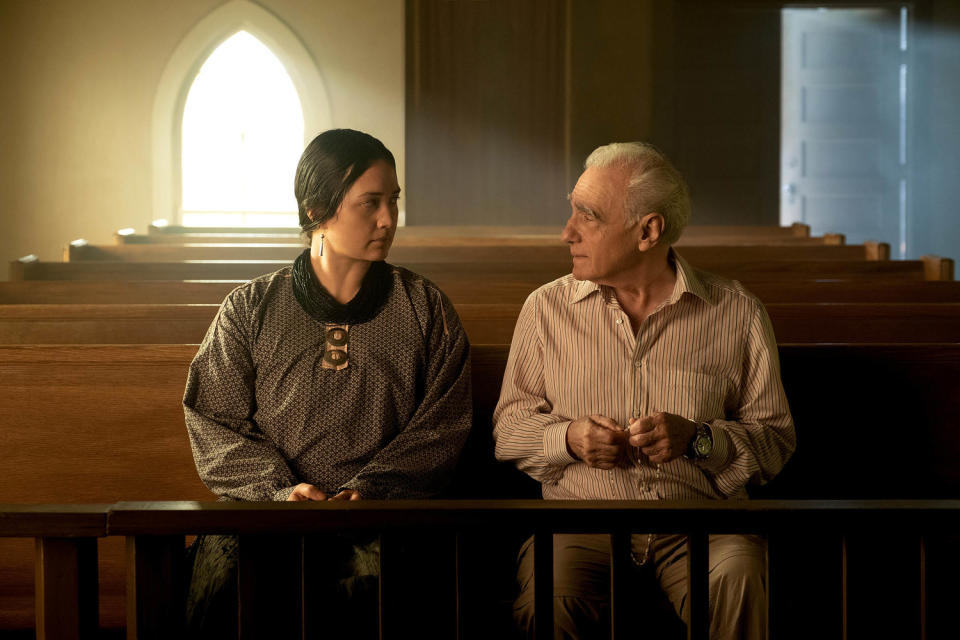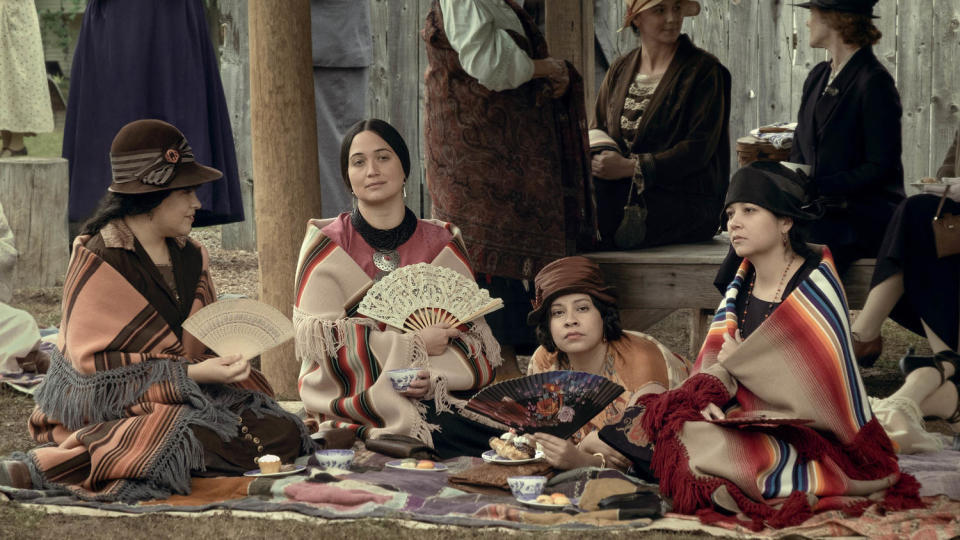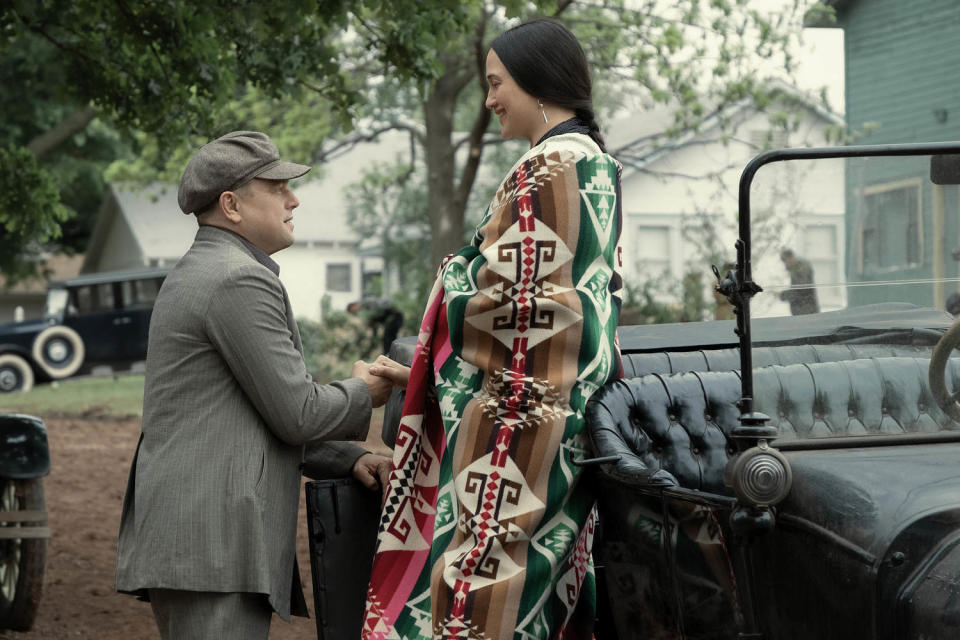'Killers of the Flower Moon’ author on the biggest differences between the book and the movie
- Oops!Something went wrong.Please try again later.
- Oops!Something went wrong.Please try again later.
- Oops!Something went wrong.Please try again later.
- Oops!Something went wrong.Please try again later.
- Oops!Something went wrong.Please try again later.
Warning: This post contains spoilers for “Killers of the Flower Moon”
Journalist David Grann first found out legendary director Martin Scorsese was interested in adapting his book, "Killers of the Flower Moon," shortly after it was published in 2017.
Since the book is about the true story of a dark, nearly untold era of history where members of the Osage Nation were murdered for their rights to oil found underneath their reservation in the early 1900s, Grann tells TODAY.com he was stunned by the interest.
"Eric Roth was hired to write the screenplay and soon after that, Martin Scorsese came on board and was attached to direct and Leonardo DiCaprio to act," he says. "The idea that the greatest-living director Martin Scorsese would be interested in developing the story... I was like any other film buff — I was astounded."
Scorsese's film, also titled "Killers of the Flower Moon," premiered on Oct. 20, and follows Mollie Burkhart, portrayed by Lily Gladstone, an Osage woman whose immediate family members begin dying in mysterious ways, from bombings to poisonings.

Mollie's husband, Ernest Burkhart, played by DiCaprio, and his uncle William Hale, portrayed by Robert De Niro, turn out to be behind the murders as they try to wrangle away Mollie's family's head rights to oil found underneath the Osage reservation.
Mollie's family is a representation of the dozens of Osage members who were killed for their oil wealth in the 1920s, in what historians have called the Reign of Terror.
Grann says he was initially nervous about the film adaptation due to the gravity and solemnness of the real-life crimes that occurred, and how it has continued to impact generations of the Osage Nation.
"You’re especially nervous in a case like this because it’s such a serious history — it’s one of the more monstrous crimes and one of the worst racial injustices in American history," Grann said. "But that nervousness was really eased when Martin Scorsese and the entire production team became deeply involved and began working so closely with the Osage Nation. I knew then that the project was in good hands."
According to "Killers of the Flower Moon" production notes, Osage actors filled more than 44 roles in the film, and the production employed Osage artisans for behind-the-scenes work including costume design, set design, and Osage language consulting to stay as true to the story as possible.
"I think it’s because of that, that the movie has a real authenticity to get to these deeper truths," Grann says. "If it wasn’t for the Osage’s involvement, that wouldn’t have been the case."

From book to screen, the biggest differences
The main differences between the book and the movie come down to the structure and format, Grann says.
"A movie and a book are always going to be two different things. They’re two different mediums — they cannot be the same thing nor should they be," he says. "My book is a work of history — every line, every sentence and every word is rooted in fact and a document and a record. So they will be different, but they share that fierce commitment to the history and to these deeper truths."
Grann describes his book as a "sweeping history" of the topic, starting when the Osage members laid claim to the land in the central part of the U.S. and going all the way up to present day.
"It’s told in three parts, and the first part is told from Mollie Burkhart’s perspective, this Osage woman whose family is being systematically targeted," he says. "The second part is told from the perspective of one of the FBI agents who is investigating the case, and the third part is told from the present and shows how there was a much deeper and darker conspiracy that the bureau never exposed — and this was really about a culture of killing and a culture of complicity."
As for the film, Grann says the movie zooms in on how the murders affected Mollie Burkhart and her community.
"The movie really hones in on the relationship between Mollie and Ernest Burkhart, which is so representational of the crimes that took place," he says. "So one is a much broader canvas and one really hones in, in a way you can only really do with a movie on this character study."
"I look at them as two complements to each other — they’re very different mediums," he continues. "But I think they’re very effective complements to each other because they’re both kind of working towards the same deeper truths, exposing them within the rigors of their own medium."
David Grann was a resource for Leonardo DiCaprio and Lily Gladstone
While Grann is a self-proclaimed film buff, he reveals that he doesn't know "anything about making a film." But he did share with TODAY.com that he was able to serve as a resource for the actors to learn more about their characters.
"I would get a lot of phone calls," he says, including hearing several times from DiCaprio as the actor worked through how to portray Ernest Burkhart.
"I was so impressed with DiCaprio. I really was, because he really is an artist and he was so devoted to figuring out the role and understanding who this person was," Grann says. "I was just so struck by his devotion and his dedication to his art. To watch how he developed and worked to embody this very complicated and quite dark character, I found it really revelatory and I was just so deeply impressed."

He also says he "could not think of anyone who could better embody Mollie Burkhart than Lily Gladstone."
"She has this force about her. She also has a kind of sly sense of humor, which I really appreciate," he says of Gladstone, adding, she "brought her to life."
"It's always sometimes surreal when you spend all your time working with records... so it's always surprising, and even a bit astonishing, to see someone suddenly embody this figure who you've come to know only through records," he adds. "But she is remarkable. I think everyone will know her name after this film."
Grann sums up his overall involvement in the film through laughter: "I was there as a resource for them when they needed me, but I would never, ever suggest to a director like Martin Scorsese how he should make his film."
This article was originally published on TODAY.com

